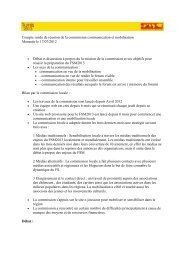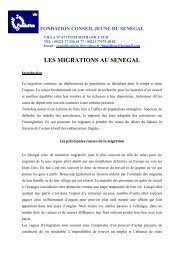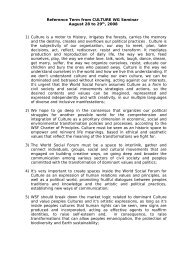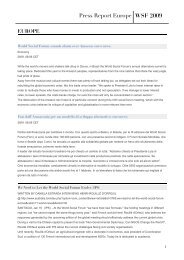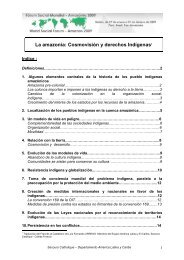Economic Liberalization and the Aftermath of War in Sri Lanka ...
Economic Liberalization and the Aftermath of War in Sri Lanka ...
Economic Liberalization and the Aftermath of War in Sri Lanka ...
Create successful ePaper yourself
Turn your PDF publications into a flip-book with our unique Google optimized e-Paper software.
ICSW Abstract Number: 3GP0022<br />
Presented at 2010 Jo<strong>in</strong>t World Conference on 13 June<br />
at Hong Kong Convention & Exhibition Center<br />
<strong>Economic</strong> <strong>Liberalization</strong> <strong>and</strong><br />
<strong>the</strong> <strong>Aftermath</strong> <strong>of</strong> <strong>War</strong><br />
<strong>in</strong> <strong>Sri</strong> <strong>Lanka</strong><br />
Presented by<br />
G. V. D. Tilakasiri,<br />
President<br />
Free Trade Union Development Centre<br />
General Secretary<br />
National Peace Council <strong>of</strong> <strong>Sri</strong> <strong>Lanka</strong><br />
Email ftudc@sltnet.lk
Perl <strong>of</strong> <strong>the</strong> Indian Ocean<br />
• <strong>Sri</strong> <strong>Lanka</strong> has a recorded<br />
history <strong>of</strong> over 2500 years.<br />
• The Portuguese <strong>in</strong>vasion<br />
<strong>in</strong> 1505, <strong>the</strong>n Dutch <strong>and</strong><br />
British ruled.<br />
• In 1948, <strong>Sri</strong> <strong>Lanka</strong><br />
atta<strong>in</strong>ed <strong>in</strong>dependence from Great Brita<strong>in</strong>.<br />
• 75 % S<strong>in</strong>halese, 25 % Tamil speak<strong>in</strong>g.
Back ground facts & figures<br />
• <strong>Sri</strong> <strong>Lanka</strong> is a multi-ethnic,<br />
multi-religious country.<br />
• Total population <strong>of</strong> 19 million<br />
• Buddhist 69.1%, Muslim 7.6%,<br />
H<strong>in</strong>du 7.1%, Christian 6.2%,<br />
unspecified 10% (1981 Census)<br />
• S<strong>in</strong>hala <strong>and</strong> Tamil languages are used as <strong>of</strong>ficial<br />
national languages. English is widely spoken.<br />
Literacy rate is 92%, <strong>the</strong> highest <strong>in</strong> South Asia.<br />
• GDP is presently US$ 2000 <strong>the</strong> highest <strong>in</strong> South<br />
Asia ( exception <strong>of</strong> <strong>the</strong> Maldives Isl<strong>and</strong>s)
Open <strong>Economic</strong> policy<br />
• In 1977, Neo-Liberal Open<br />
<strong>Economic</strong> Policy was<br />
implemented ruthlessly.<br />
• Free Trade Zones (FTZs)<br />
were established.<br />
• Reduced <strong>the</strong> Public Services.<br />
• Privatized public properties<br />
• Cut down welfare spend<strong>in</strong>g <strong>and</strong><br />
liberalized <strong>the</strong> f<strong>in</strong>ancial market
<strong>Economic</strong> Reforms <strong>and</strong> Conflicts<br />
• Introduced large scale projects<br />
bound with <strong>the</strong> IMF loans.<br />
(Mahawali Dam project )<br />
• Reduced budgetary<br />
expenditures for health,<br />
education <strong>and</strong> social welfare.<br />
• Stop rice <strong>and</strong> commodity goods subsidies.
Developed Social Unrest<br />
• Adjusted exchange rate <strong>in</strong><br />
1978 from US$1=Rs.8.50 to<br />
US$1=Rs.16/-(Now Rs.115/-)<br />
• Inflation rate <strong>in</strong>creased<br />
from 5% to13% <strong>in</strong> 1980.<br />
• Trade Unions dem<strong>and</strong>ed Rs.10/- per day <strong>and</strong><br />
Rs.2.50 for <strong>in</strong>creas<strong>in</strong>g <strong>of</strong> each Cost <strong>of</strong> Liv<strong>in</strong>g<br />
Po<strong>in</strong>ts.<br />
• Jo<strong>in</strong>t Trade Union Action Committee call a<br />
General Strike on July 17,1980.
Workers Protested Aga<strong>in</strong>st <strong>the</strong><br />
Dictatorial Regime<br />
• UNP right w<strong>in</strong>g<br />
government announced<br />
24 hours time <strong>and</strong><br />
sacked 100,000 strikers.<br />
• August 08,1980 JTUCA declared<br />
SATHYAGRAHA protest <strong>and</strong> strikers came to<br />
<strong>the</strong> rode.<br />
• They began street fights with army <strong>and</strong><br />
police. TU leaders arrested. 24 workers died<br />
from suicide actions after <strong>of</strong> <strong>the</strong> depression.
1983 Holocaust<br />
Anti-Tamil Activities.<br />
• 1983, <strong>the</strong> government<br />
engaged military conflict<br />
with <strong>the</strong> Liberation Tigers<br />
<strong>of</strong> Tamil Eelam (LTTE)<br />
• 1983 July, anti-Tamil<br />
S<strong>in</strong>hala masses came<br />
to street <strong>and</strong> killed Tamil ord<strong>in</strong>ary people<br />
openly on <strong>the</strong> roads, looted <strong>and</strong> burned <strong>the</strong>ir<br />
properties with <strong>the</strong> help <strong>of</strong> right w<strong>in</strong>g<br />
government supporters.
JVP - S<strong>in</strong>hala Youth Unrest<br />
• Dur<strong>in</strong>g <strong>the</strong> 1988-89 period JVP<br />
(Sou<strong>the</strong>rn S<strong>in</strong>hala Buddhist youth)<br />
led terror, <strong>in</strong>surrection aga<strong>in</strong>st NEP.<br />
• Grow<strong>in</strong>g unemployment,<br />
underemployment <strong>in</strong> rural areas,<br />
broken down <strong>of</strong> <strong>the</strong>ir susta<strong>in</strong>able liv<strong>in</strong>g pattern.<br />
• In 1988-89, Right w<strong>in</strong>g President<br />
Premadasa crushed <strong>the</strong> JVP.<br />
• Disappeared over 60,000 youth<br />
<strong>in</strong>clud<strong>in</strong>g Wijeweera <strong>and</strong><br />
Gamnayakea JVP leaders by <strong>the</strong> government.
Tamil Youth Unrest<br />
• Open economic policies<br />
widened wage gaps,<br />
destroyed livelihoods<br />
<strong>of</strong> both S<strong>in</strong>hala <strong>and</strong><br />
Tamil people.<br />
• Neo-Liberal <strong>Economic</strong> Policy exhausted<br />
self susta<strong>in</strong><strong>in</strong>g farm<strong>in</strong>g systems that <strong>the</strong><br />
majority <strong>of</strong> Tamil liv<strong>in</strong>g <strong>in</strong> <strong>the</strong> North <strong>and</strong><br />
East areas.
Tamil Youth Took Up Arms<br />
• Tamil youth took up arms<br />
aga<strong>in</strong>st <strong>the</strong> state.<br />
• Cause <strong>of</strong> youth unrest,<br />
deepen<strong>in</strong>g <strong>of</strong> <strong>the</strong> division<br />
between Tamils, S<strong>in</strong>hales.<br />
• Indian Peace Keep<strong>in</strong>g Force<br />
sent back on 24 March 1990.<br />
• SL s<strong>in</strong>ged MOU with LTTE<br />
facilitation <strong>of</strong> Norway on<br />
Feb 22, 2002.
LTTE Militarily Defeated.<br />
• In 2005, SL majority <strong>of</strong> people<br />
rejected <strong>the</strong> UNP & <strong>the</strong>ir<br />
<strong>Economic</strong> <strong>and</strong> International<br />
policies. MOU was Broken.<br />
• Elected Mah<strong>in</strong>da Rajapakse<br />
as The New President <strong>in</strong> SL<br />
• In May 2009, <strong>the</strong> government<br />
militarily defeated <strong>the</strong> LTTE,<br />
destroyed leader Prbakarn<br />
<strong>and</strong> <strong>the</strong>ir senior leaders<br />
<strong>in</strong> <strong>the</strong> Nor<strong>the</strong>rn battle front.
Enough is Enough<br />
• People need to stop anti-people Neo-Liberal<br />
Open <strong>Economic</strong> Policies.<br />
• Implement a susta<strong>in</strong>able<br />
economic policy.<br />
• Exp<strong>and</strong> <strong>the</strong> welfare state<br />
for benefit <strong>of</strong> <strong>the</strong> masses.<br />
• Higher pr<strong>of</strong>its are not for <strong>the</strong> mult<strong>in</strong>ational<br />
corporations, <strong>in</strong>ternational banks <strong>and</strong><br />
wealthy companies, it should be for welfare<br />
<strong>of</strong> people.
International Support & Solidarity<br />
• F<strong>in</strong>al stages <strong>of</strong> <strong>the</strong> war<br />
lost over 60,000 lives,<br />
<strong>and</strong> 300,000 <strong>of</strong> people<br />
displaced, still 80,000 <strong>in</strong><br />
<strong>the</strong> welfare camps.<br />
• There are 3000 children who have lost both<br />
parents. Over 40000 widows live <strong>in</strong><br />
<strong>the</strong> war affected areas. In <strong>the</strong> Sou<strong>the</strong>rn part<br />
most <strong>of</strong> <strong>the</strong>m are soldiers’ families.<br />
• Hous<strong>in</strong>g, resettlement; women-led families,<br />
children’s education, health are <strong>the</strong> problems
Hope <strong>of</strong> Peace, Democracy &<br />
Development




